2.5 Earth’s Energy Budget
Explain Earth’s energy budget and why the atmosphere circulates.
The fraction of the Sun’s energy that Earth intercepts is called insolation, or incoming solar radiation. According to satellite measurements, 1,367 W/m2 of solar energy reaches the top of the atmosphere. Insolation is transmitted, scattered, reflected, and absorbed in Earth’s physical systems as it travels through the atmosphere to Earth’s surface.
insolation
(or incoming solar radiation) Solar radiation that reaches Earth.
Transmission is the unimpeded movement of electromagnetic energy through a medium such as air, water, or glass. Ocean water transmits sunlight to limited depths. Some materials transmit only certain wavelengths of electromagnetic radiation. The atmosphere, for example, absorbs ultraviolet and infrared wavelengths but transmits visible wavelengths. Glass, on the other hand, transmits visible light but absorbs ultraviolet wavelengths.
transmission
The unimpeded movement of electromagnetic energy through a medium such as air, water, or glass.
Scattering is the process of redirecting solar radiation in random directions as it strikes physical matter, such as aerosols, gases, or the planet’s surface. This process creates diffuse light. When light is scattered, its electromagnetic wavelength does not change; only its direction of travel changes (Figure 2.28).
scattering
The process of redirecting solar radiation in random directions as it strikes physical matter.
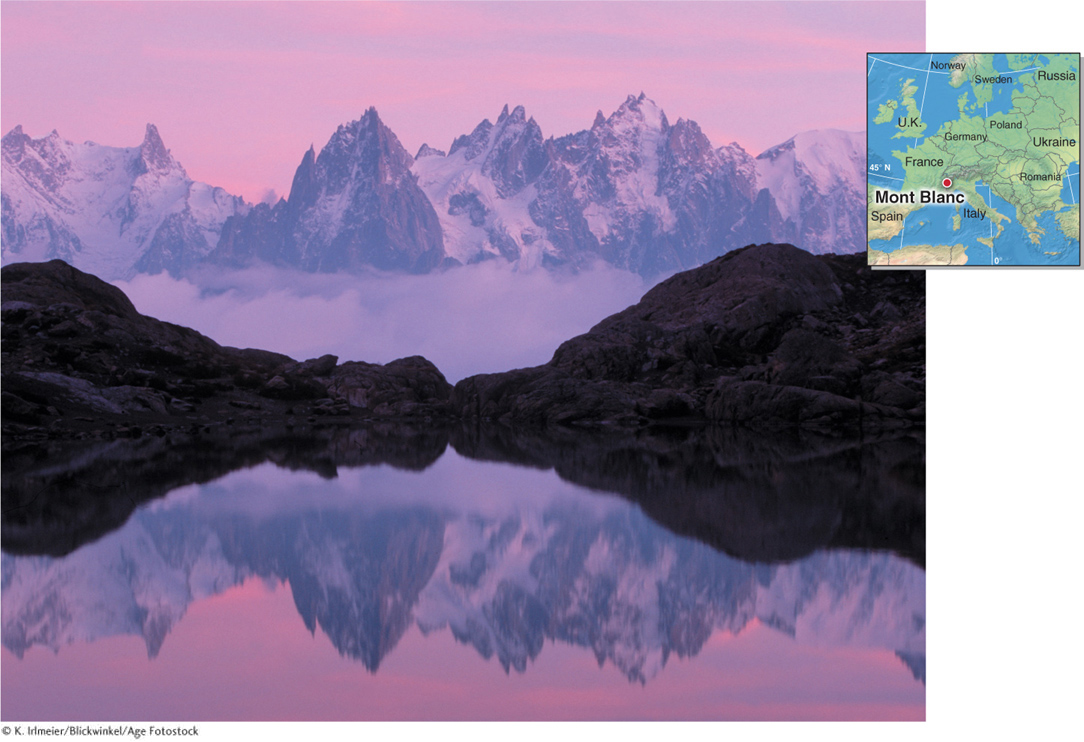
Reflection, like scattering, does not alter the wavelength of electromagnetic radiation. Reflection is the process of returning a portion of the radiation striking a surface in the general direction from which it came. If, for example, a UV photon is reflected off snow, it goes back into the atmosphere as a UV photon, unchanged.
reflection
The process of returning a portion of the radiation striking a surface in the general direction from which it came.
Question 2.11
Why is the sky blue and the grass green?
The sky is blue because nitrogen in the atmosphere scatters blue sunlight. The grass is green because green light is reflected and all other colors are absorbed by the chlorophyll contained in grass.
The colors our eyes perceive are the result of reflection, refraction, scattering, and absorption of visible wavelengths (Picture This).
Picture This
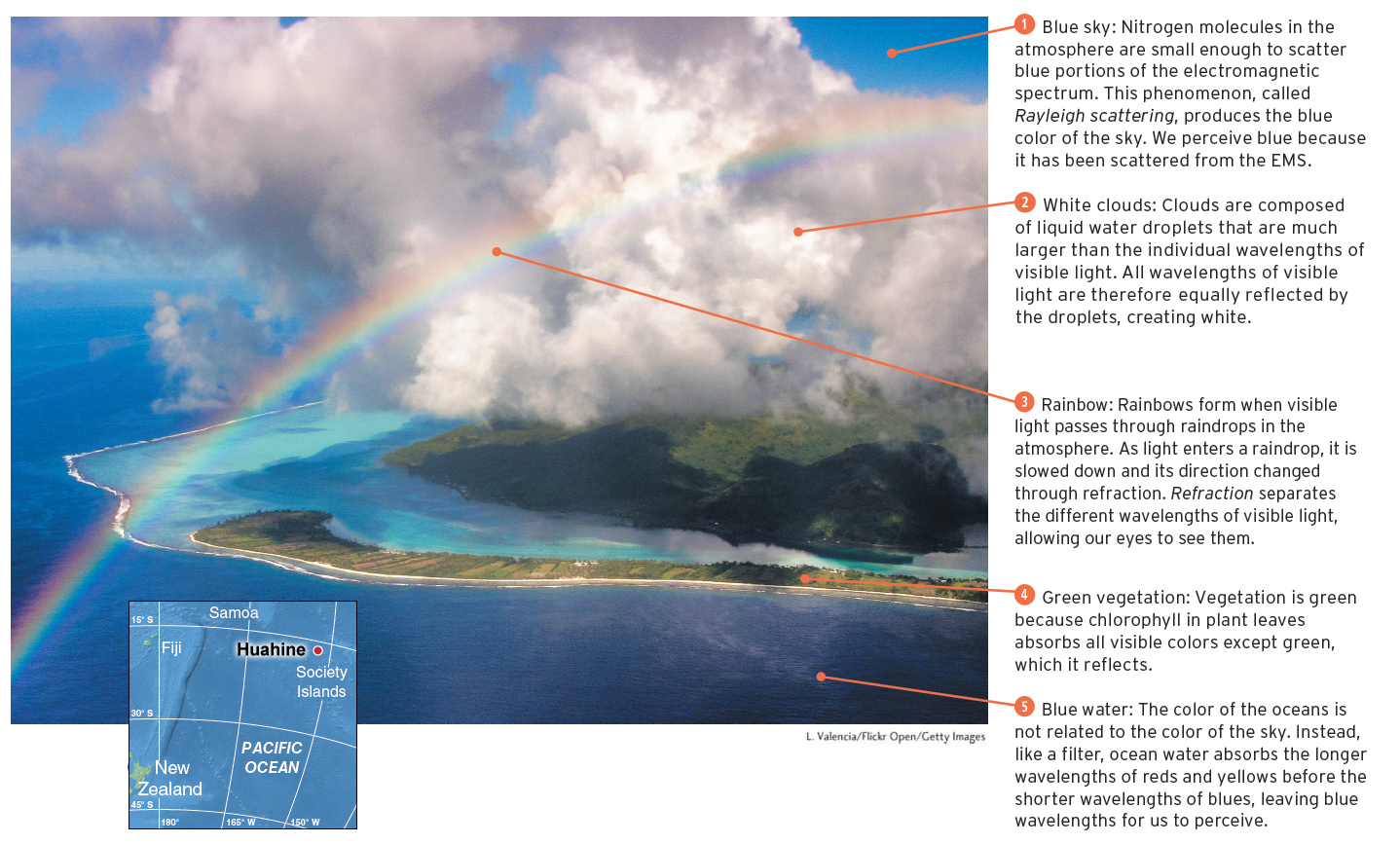
Colors
This aerial photograph of Huahine, part of the Society Islands in French Polynesia, shows a world awash in tropical sunlight and color. Colors are produced when visible light is reflected, refracted, scattered, or absorbed.
Consider This
Question 2.12
If the Sun burned hotter, what effect (if any) do you think this would have on colors? Explain your reasoning.
Question 2.13
We learned in this chapter that the Sun’s peak energy output is centered on green wavelengths in the visible spectrum. Why, then, is the Sun not colored green?
Albedo is the reflectivity of a surface, given as the percentage of incoming radiation that it reflects. Lighter-
albedo
The reflectivity of a surface, given as the percentage of incoming radiation that it reflects.
The albedo of Earth, taken as a whole, is 30%. The 70% of insolation not reflected back to space is absorbed. The planet’s surface albedo, however, varies considerably from region to region. Surfaces with a low albedo absorb more insolation than do objects with a high albedo. For example, clean snow absorbs about 10% of insolation and reflects the remaining 90%. Older and dirtier snow is less reflective. Figure 2.29 illustrates the different albedos of various surfaces.

Except in the case of incandescent lava or bioluminescent organisms, Earth does not emit light—
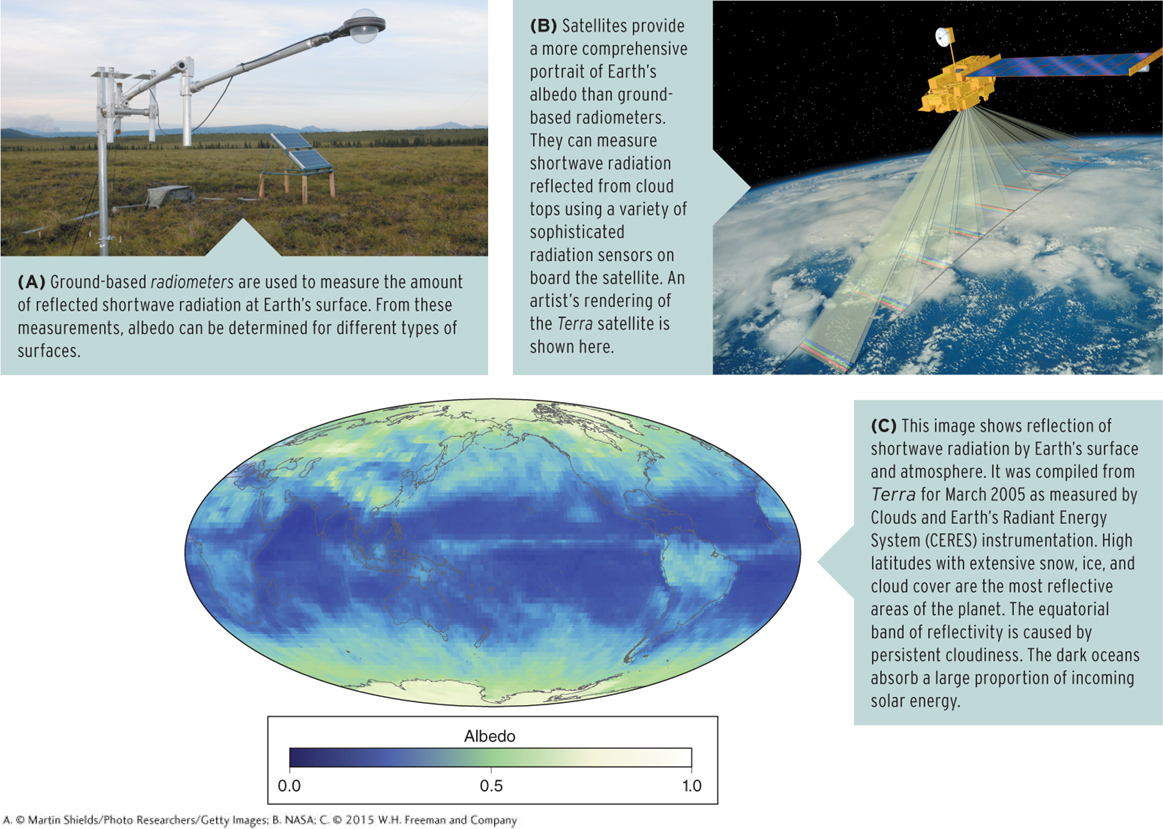
 Once a photon is absorbed, it ceases to exist in its original state. It is instead converted to another form of energy. The solar energy absorbed by plants is converted to chemical energy. Solar panels absorb solar energy and convert it to electrical energy (see Geographic Perspectives at the end of this chapter).
Once a photon is absorbed, it ceases to exist in its original state. It is instead converted to another form of energy. The solar energy absorbed by plants is converted to chemical energy. Solar panels absorb solar energy and convert it to electrical energy (see Geographic Perspectives at the end of this chapter).
Most objects convert absorbed solar energy to longwave radiation (heat), which raises the temperature of the object that absorbed it.
In general, the more shortwave energy an object can absorb (or the lower its albedo), the more longwave energy it can radiate. How much shortwave radiation an object can absorb depends on its heat capacity and its albedo. For example, an urbanized region may become significantly warmer than surrounding rural areas, forming an urban heat island (Figure 2.31).
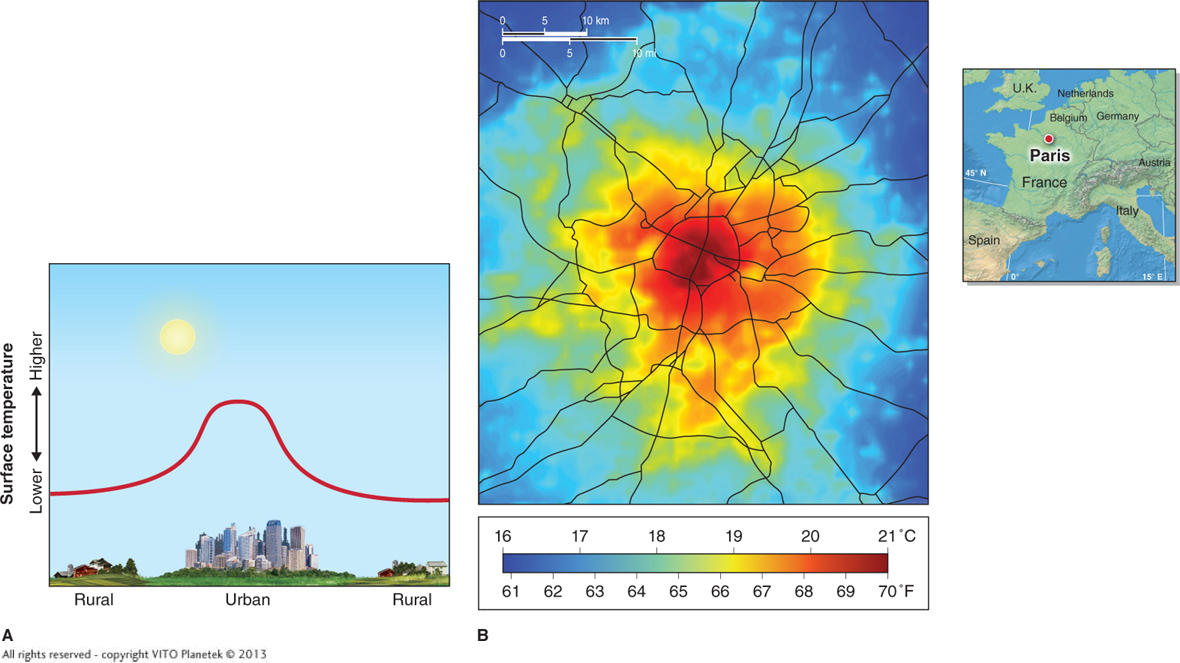
urban heat island
An urbanized region that is significantly warmer than surrounding rural areas.
Urban heat islands result from three main factors. First, cities have low albedos which allows them to absorb solar radiation. Second, cities are composed of materials such as asphalt, concrete, and bricks, which retain the absorbed heat energy and radiate it. Third, because evaporation cools the surrounding environment (see Section 3.1), the lack of water available for evaporation in cities also contributes to the urban heat island effect.
In a different example of a relationship between albedo and human comfort, the Tuareg people who inhabit the hot Sahara wear dark clothing, seemingly against common sense (Picture This).
Picture This
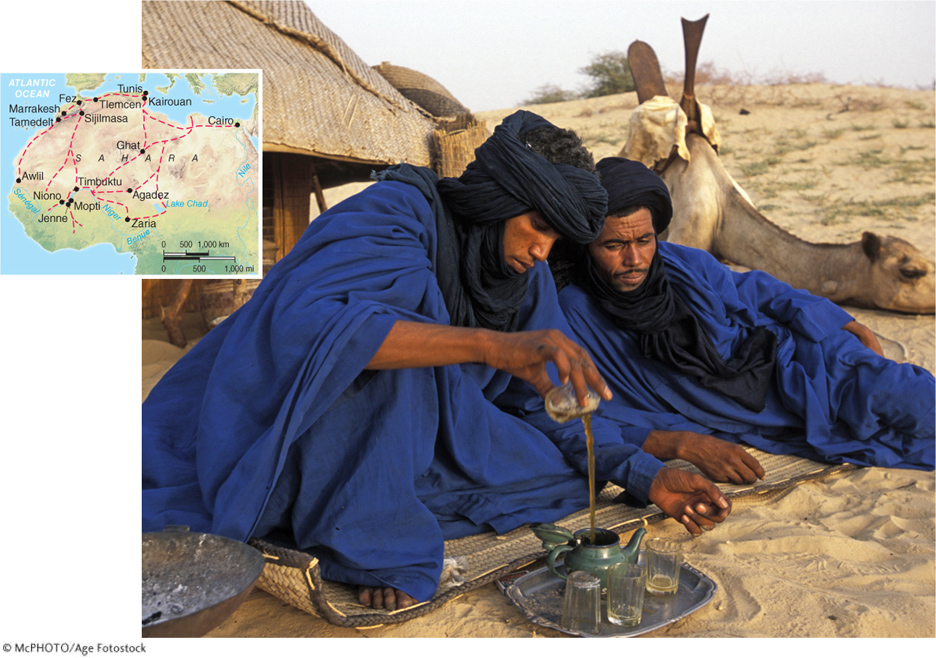
The Tuareg
The Tuareg are a group of nomadic Berber people who inhabit the Sahara of northern Africa. The Tuareg have occupied this desert region for at least 1,500 years, making a living by transporting goods with camels between sub-
Traditional Tuareg dress often consists of loose-
Cultural reasons come into play in the choice of clothing color. However, from a physical standpoint, dark colors do make practical sense. Studies have shown that white clothing reflects heat back toward the body, while dark clothing better absorbs the body’s heat (as well as the Sun’s). As long as there is some wind to carry the excess heat away, dark, loose-
Consider This
Question 2.14
Would dark, tight-
fitting clothing be an advantage in hot places? Explain. Question 2.15
Have you ever noticed that the albedo of your clothing affects your body temperature, particularly in the context of playing sports? Explain.
The Great Balancing Act
Earth’s surface temperature increases as Earth absorbs energy from the Sun, and it decreases as Earth radiates heat to the atmosphere and to space. Internal geothermal energy does warm Earth’s surface, but not as much as the Sun’s energy does. If the Sun were to stop shining, the temperature of Earth’s surface would plunge as it quickly radiated away its heat. Each night, the Sun effectively does stop shining, and the surface temperature drops because Earth loses more energy than it absorbs. Each day, the Sun rises again, and Earth’s surface warms again because it absorbs more energy than it radiates (Figure 2.32). The atmosphere also warms and cools over a 24-

Just as a bank account’s balance is the result of deposits and withdrawals, the temperature of Earth’s surface and atmosphere is the result of a balance between incoming and outgoing energy. As long as the amount of energy absorbed is equal to the amount of energy radiated, the temperature will be stable, as illustrated in Figure 2.33. That stable temperature is called the radiative equilibrium temperature.
radiative equilibrium temperature
The temperature of an object resulting from the balance between incoming and outgoing energy.
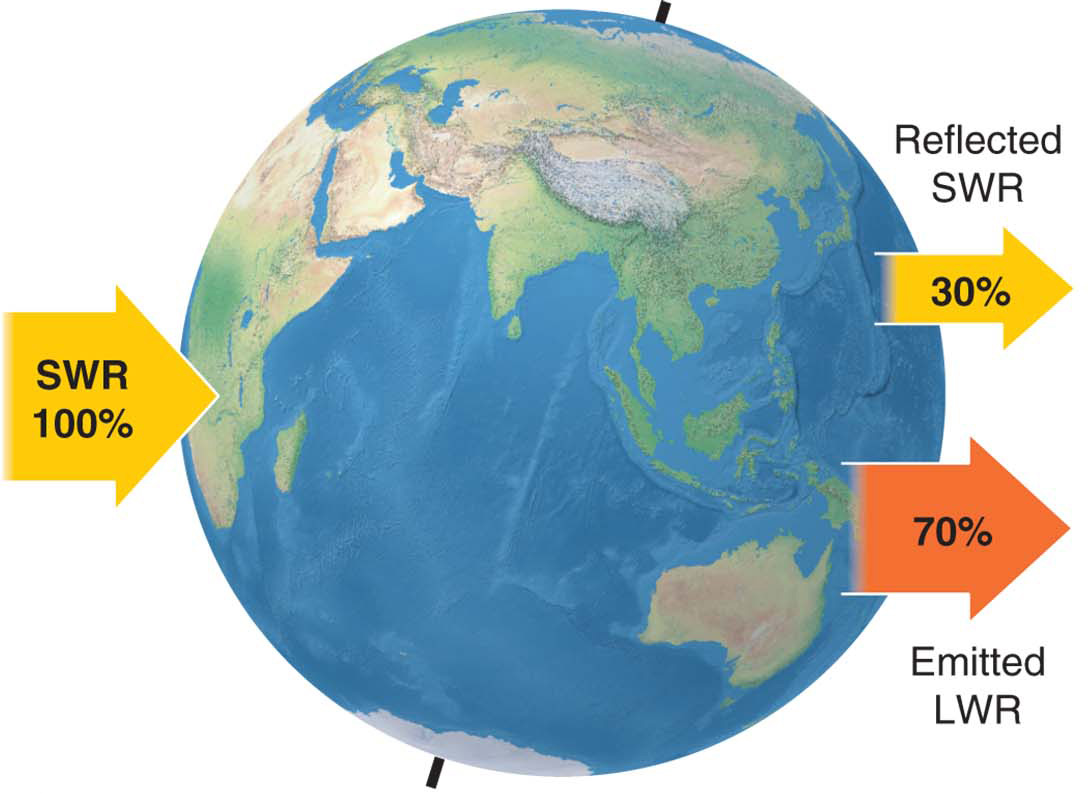
Although incoming solar SWR and outgoing terrestrial LWR are balanced, some complex and important interactions are involved, as illustrated in Figure 2.34. One of the most important aspects of Earth’s radiation budget is the greenhouse effect, which delays the radiation of heat absorbed by Earth’s surface to space. The greenhouse effect is the process by which the atmosphere is warmed as greenhouse gases, such as water vapor, carbon dioxide, and methane (see Section 1.1), and clouds absorb some of the heat emitted by Earth's surface, then counterradiate (or reradiate) that heat.
greenhouse effect
The process by which the atmosphere is warmed as greenhouse gases (such as water vapor, carbon dioxide, and methane) and clouds absorb and counterradiate heat.
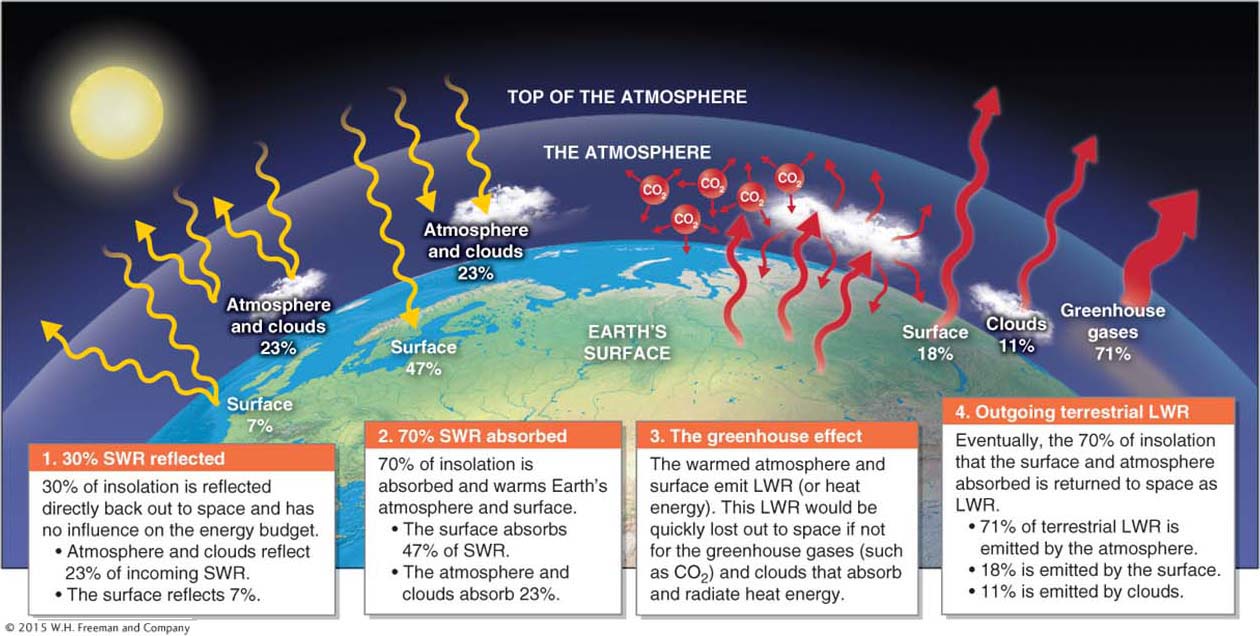
Heat is not “trapped” through the greenhouse effect. That would mean that it never radiates back to space. If heat were trapped, Earth’s atmosphere would have long ago become extremely hot and inhospitable for life. Conversely, if it were not for the presence of greenhouse gases in the atmosphere, the greenhouse effect would not occur. The lower atmosphere would be, on average, some 30°C (54°F) colder than it is, cold enough to freeze the oceans. Humans have modified the greenhouse effect by adding greenhouse gases to the atmosphere; this important topic will be discussed in Section 6.3.
The Global Heat Engine
For the planet as a whole, incoming SWR and outgoing terrestrial LWR are balanced. But across most of Earth’s surface, incoming and outgoing energy are not balanced. At most latitudes, there is either a surplus or a deficit of heat (Figure 2.35).
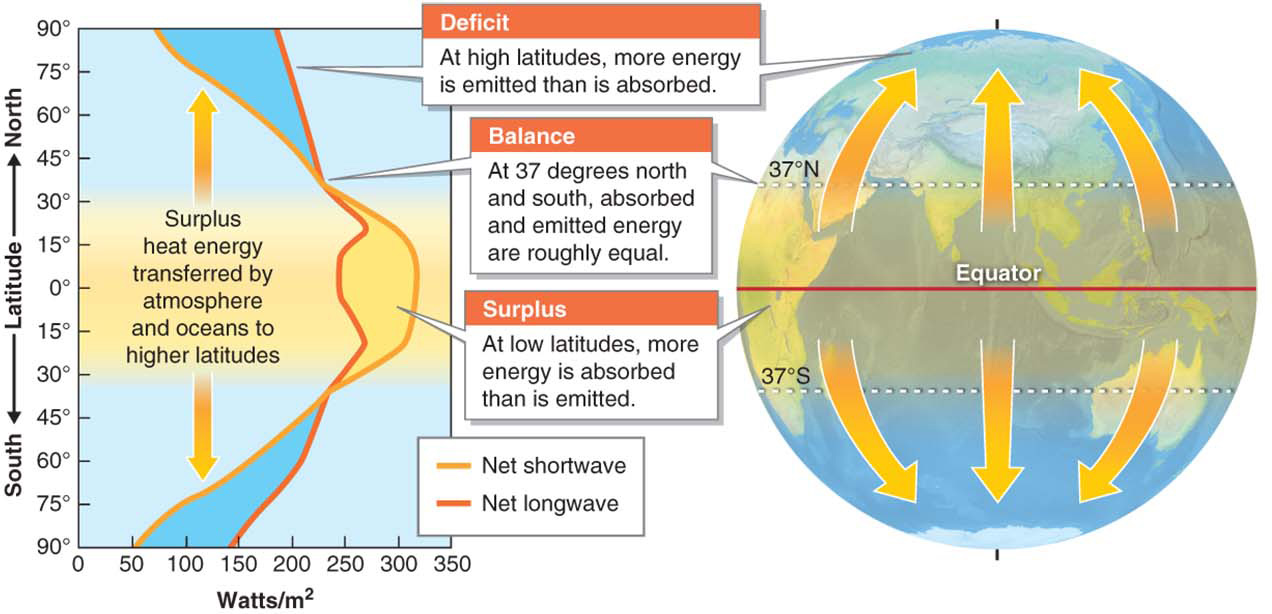
Between 37° north and south, Earth absorbs more energy than it radiates. Earth should therefore be heating up at a constant rate there, but it is not. The tropics are warm, but they are not growing warmer. Likewise, because Earth radiates more heat than it absorbs poleward of 37°, it should be growing ever colder at high latitudes, but it is not. Instead, heat from tropical latitudes is advected (moved) poleward by the atmosphere and the oceans.
Heat is also imbalanced between the lower and upper atmosphere. Air near Earth’s surface is usually warmer than air at higher altitudes because Earth’s surface absorbs more solar energy than the atmosphere does. Heat is transferred to the atmosphere through radiation.
Earth’s atmosphere and oceans flow mainly because of unequal heating across Earth’s surface. The atmosphere moves about 60% of excess tropical heat to higher latitudes, and the oceans move about 40%. The movement of heat from low to high latitudes and low to high altitudes as a result of heating differences is called the global heat engine.
global heat engine
The movement of heat from low to high latitudes and low to high altitudes as a result of heating differences.
Question 2.16
Why does the wind blow?
Wind is the result of heating inequalities across latitude and altitude. Together, local convection and the global heat engine cause the atmospheric movement we perceive as wind.
Almost all atmospheric movement, from gentle breezes to tornadoes, is the result of heating inequalities across latitude and altitude. Together, local convection and the global heat engine transport immense amounts of heat, both higher in latitude and higher in altitude. Water vapor, as we will see in Chapter 3, also plays a vitally important role in the global heat engine. The global heat engine underpins all the atmospheric processes explored in the remainder of Part I (Chapters 3 to 6).
